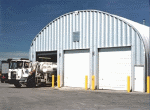
The weather conditions in Florida and along the rest of the Atlantic and Caribbean coasts can be harsh. Developers and savvy property owners know that prefab steel buildings offer not only excellent economic value, but also superb strength and durability in all weather conditions, no matter how severe.
You can see in the wind load map of Florida that the building code requires Florida structures to withstand winds of at least 115mph. On the southern coast, buildings must be designed for winds as high as 180mph. It takes a durable building to withstand winds that strong! However, the wind speeds don't tell the whole story.
Wind doesn't just blow into the near side of a building. It also causes suction on the opposite side and uplift on the top. Moreover, hurricane force winds can be unpredictable. They can form eddies and hit buildings with unexpected force from almost any direction. Those loads have to be transferred from the cladding to the girts to the frame. No material is better for standing up to those winds than meticulously detailed steel: steel cladding, steel girts, high quality steel fasteners, and of course a steel frame.
Steel is a strong and ductile material. Steel isn't brittle, and it can withstand forces that try to bend and stretch it just as easily as it can support heavy loads. Compare that to the behavior of concrete block, brick and even poured concrete. They can support high gravity loads, but aren't as good with the kind of erratic forces that can be caused by hurricane-force winds.
An all-steel building is a wise choice for hurricane prone coastal regions. However, not every prefab steel building is engineered for coastal weather. When you choose a steel building manufacturer, choose one who's not just going to design your building frame for the wind loads in the Building Code. Choose one who knows how to detail the building properly to prevent damage to the doors, windows, roof and cladding in the most severe weather conditions.
The best metal buildings don't just meet the minimum standards set by code. They anticipate the weather conditions that we may be seeing in the future. Weather patterns around the world have been changing a lot recently. We're seeing bigger earthquakes, longer summers, and colder winters. For this reason, we believe building codes should be viewed as a minimum requirement.
Ian Strompf is specialized in building materials and recommends MBMI Metal Buildings.

